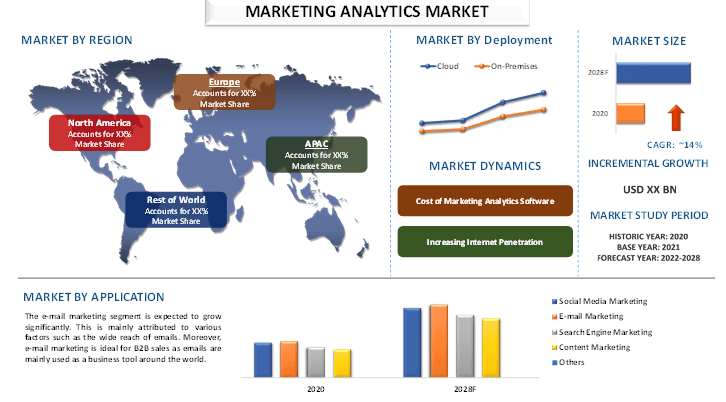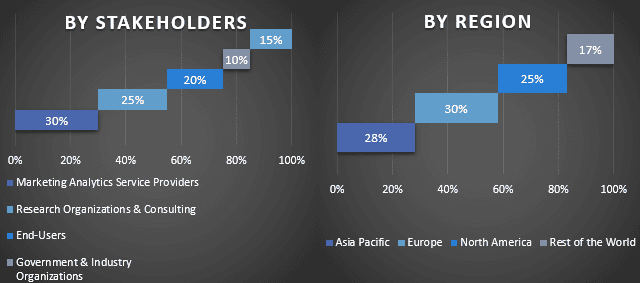
全球营销分析市场预计在预测期内以约14%的显著速度增长。 营销分析软件包括工具和流程,使组织能够通过衡量营销绩效来管理、评估和控制其营销工作。简而言之,这些解决方案简化并优化了企业的营销策略和活动。通过使用营销分析软件,企业能够通过识别有效的营销方法并调整广告活动以最大限度地提高转化率和销售额来提高其投资回报率 (ROI)。
营销分析软件的日益普及归因于组织越来越需要更有效地渗透市场以及理解消费者需求的复杂性。此外,使用营销分析使公司能够更好地了解其营销活动的效果,并进行比较分析,以了解哪种应用提供的回报最高。
Accenture Plc、Adobe Inc、Google Inc、Funnel、IBM Corporation、Oracle Corporation、RTB Digital Media Corporation、SAS Institute Inc、Tableau Software LLC 和 Teradata Corporation。是市场上的一些主要参与者。这些参与者已经进行了多次并购以及合作,以向客户提供高科技和创新产品/技术。
报告中呈现的见解
“在部署方式中,云类别预计在预测期内将见证强劲的复合年增长率”
根据部署方式,市场分为本地部署和云部署。预计云细分市场在预测期内将显著增长。云实施非常具有成本效益。此外,许多中小企业更喜欢采用云部署模型,因为它使他们能够在不更改现有IT基础设施的情况下利用营销分析软件
“在应用方面,电子邮件营销将在2020年占据市场的重要份额”
根据应用,市场分为社交媒体营销、电子邮件营销、搜索引擎营销、内容营销等。在预测期内,电子邮件营销细分市场预计将显著增长。这主要归因于各种因素,例如电子邮件的广泛覆盖范围。此外,电子邮件营销非常适合 B2B 销售,因为电子邮件主要用作世界各地的业务工具。
“北美将在市场中占据重要份额”
2020 年,北美引领了营销分析市场。这主要归因于社交媒体使用的日益普及,以及美国和加拿大等国家/地区互联网普及率的提高。此外,该地区重要的电子商务生态系统为营销人员提供了分析电子商务销售产生的数据的机会,从而提供有关客户购买偏好的见解,这有助于设计高效的营销策略。此外,机器学习 (ML)、自然语言处理 (NLP) 和人工智能 (AI) 的日益使用进一步增强了该地区营销分析的能力
购买此报告的理由:
- 该研究包括经过认证的关键行业专家验证的市场规模和预测分析。
- 该报告一目了然地介绍了整个行业绩效的快速回顾。
- 该报告深入分析了主要的行业同行,主要侧重于关键业务财务、产品组合、扩张战略和最新发展。
- 详细考察行业中存在的驱动因素、限制因素、关键趋势和机遇。
- 该研究全面涵盖了跨不同细分市场的市场。
- 深入的行业区域层面分析。
定制选项:
全球营销分析市场可以根据要求或任何其他细分市场进一步定制。除此之外,UMI 了解您可能拥有自己的业务需求,因此请随时与我们联系以获取完全满足您需求的报告。
目录
营销分析市场分析(2022-2028)的研究方法
分析历史市场、估算当前市场和预测全球营销分析市场的未来市场是为创建和分析全球主要地区营销分析的采用情况而采取的三个主要步骤。 进行了详尽的二级研究,以收集历史市场数据并估算当前市场规模。 其次,为了验证这些见解,考虑了许多发现和假设。 此外,还与全球营销分析市场价值链中的行业专家进行了详尽的一级访谈。 在通过一级访谈对市场数据进行假设和验证后,我们采用了自上而下/自下而上的方法来预测完整的市场规模。 之后,采用市场细分和数据三角测量方法来估计和分析行业相关细分市场和子细分市场的市场规模。 详细方法如下所述:
历史市场规模分析
第 1 步:深入研究二级来源:
进行了详细的二级研究,通过公司内部来源(如年度报告和财务报表、业绩演示文稿、新闻稿等)和外部来源(包括期刊、新闻和文章、政府出版物、竞争对手出版物、行业报告、第三方数据库和其他可信出版物)来获取营销分析市场的历史市场规模。
第 2 步:市场细分:
在获得营销分析市场的历史市场规模后,我们进行了详细的二级分析,以收集主要地区不同细分市场和子细分市场的历史市场见解和份额。 报告中包含的主要细分市场为部署和应用。 此外,还进行了国家/地区层面的分析,以评估该地区测试模型的总体采用情况。
第 3 步:因素分析:
在获得不同细分市场和子细分市场的历史市场规模后,我们进行了详细的因素分析,以估计营销分析市场的当前市场规模。 此外,我们使用因变量和自变量(如营销分析的各种部署和应用)进行了因素分析。 考虑到全球营销分析市场领域的顶级合作、并购、业务扩张和产品发布,对需求和供应方情景进行了全面分析。
当前市场规模估算与预测
当前市场规模:基于上述 3 个步骤的可操作见解,我们得出了当前市场规模、全球营销分析市场中的主要参与者以及细分市场的市场份额。 所有必需的百分比份额拆分和市场细分均使用上述二级方法确定,并通过一级访谈进行了验证。
估算与预测:对于市场估算和预测,为不同的因素分配了权重,包括驱动因素和趋势、制约因素以及利益相关者可获得的机会。 在分析了这些因素之后,应用了相关的预测技术,即自上而下/自下而上的方法,以得出全球主要市场不同细分市场和子细分市场到 2028 年的市场预测。 采用的估计市场规模的研究方法包括:
- 该行业的市场规模,以收入(美元)和国内主要市场营销分析市场的采用率衡量
- 所有市场细分和子细分的百分比份额、拆分和细分
- 全球营销分析市场中按提供产品划分的主要参与者。 此外,这些参与者为在快速增长的市场中竞争而采取的增长策略
市场规模和份额验证
一级研究:与主要地区的关键意见领袖 (KOL) 进行了深入访谈,包括高级管理人员(CXO/VP、销售主管、营销主管、运营主管、区域主管、国家/地区主管等)。 然后总结一级研究结果,并进行统计分析以证明所述假设。 一级研究的输入与二级研究结果相结合,从而将信息转化为可操作的见解。
不同地区一级参与者的分布

市场工程
采用数据三角测量技术来完成整体市场估算,并得出全球营销分析市场每个细分市场和子细分市场的精确统计数据。 在研究了全球营销分析市场部署和应用领域的各种参数和趋势之后,数据被分为几个细分市场和子细分市场。
全球营销分析市场研究的主要目标
该研究明确指出了全球营销分析市场的当前和未来市场趋势。 投资者可以获得战略见解,从而根据研究中进行的定性和定量分析来决定投资。 当前和未来的市场趋势决定了区域层面的市场整体吸引力,为行业参与者提供了一个利用未开发市场以从先发优势中受益的平台。 该研究的其他定量目标包括:
- 分析营销分析市场当前和预测的市场规模,以价值(美元)衡量。 此外,分析不同细分市场和子细分市场当前和预测的市场规模
- 研究中的细分市场包括部署和应用领域。
- 定义和分析营销分析的监管框架
- 分析与各种中介机构的存在相关的价值链,以及分析行业的客户和竞争对手行为。
- 分析主要区域营销分析市场当前和预测的市场规模。
- 报告中研究的地区主要国家包括亚太地区、欧洲、北美洲和世界其他地区。
- 营销分析市场的公司概况以及市场参与者为在快速增长的市场中维持发展而采取的增长策略
- 深入分析该行业的区域层面
相关 报告
购买此商品的客户也购买了










